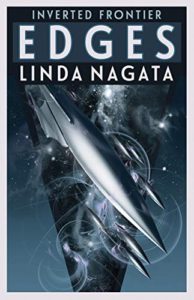Edges capably starts a new sequence of Inverted Frontier novels set in the far future universe that first made the reputation of its author, Linda Nagata.
Back in the 1990s, Cyberpunk and nanotech and transhumanism had a boom of novels and idea exploration. The first wave of cyberpunk led by Neuromancer and its ilk was succeeded by novels that pushed the concept further, exploring the consequences of programmable matter, multiple lives across copies, virtual existences, and fantastic landscapes and settings across the Earth and beyond. From Kathleen Ann Goonan to Walter Jon Williams, a number of authors explored this space.

In the mid-90s with The Bohr Maker, new author Linda Nagata began to explore this space in a trilogy of novels, taking these concepts and adding alien nanotechnology, spacecraft and big ideas and perspective of her own to the mix.Before books like The Red and The Last Good Man, this is where I first got introduced to the wonderful worlds of her work. I was in a phase where I was hunting award winners and nominees to expand my horizons. The Bohr Maker won the Locus Award for best first novel. And so I was off and into her work.
And so we now come to Edges, the first novel in the Inverted Frontier sequence by Linda Nagata, set in that same universe as the Nanotech novels. Our setting is Deception Well (the title of the second novel) and it’s set centuries after the events of the third novel in the sequence, Vast. Versions of two of the characters in that novel, Clemantine and Urban, feature in this novel. A digital version of Clemantine has long been in storage in the archives of Deception Well, awaiting the call to awaken if something a danger to the colony should suffer.
Something like, say, a Chenzeme warship on an intersect course with the solar system. The ship turns out to be under the control of Urban, and he has a proposal that leads Clemantine, and others, to join him on the ship for a centuries long trip back toward Earth and the long lost regions around it. What happened to the now silent civilizations of humanity? Did the implacable Chenzeme destroy them? Urban Clemantine and their comrades intend to find out.
As opposed to much of the recent work by Nagata, as good as it has been, from The Red Trilogy, through The Last Good Man, as well as her fantasy duology, the world of the Nanotech Succession, particularly, has felt more the central home for me for Nagata’s work. (She has a couple of unconnected novels also exploring nanotechnology and hard future SF). So I was excited to dive into this return to the Nanotech Succession verse.
It was well and good to see versions/aspects of the familiar (20 years removed, mind) of Urban and Clemantine and they are the central characters of the narrative. The author fills out the cast with a number of Deception Well, but the real focus is on the pair. Time has changed both of them, as well as digital editing and other transhuman aspects to their existence. Nagata clearly delights in the exploration and explication of the ideas of multiple existence, memory editing, personality editing, and making virtual “ghosts” of oneself devoted to various tasks.
In addition, the central conceit of the book, the idea of an enemy Chenzeme warship under leash if not under complete control, is a fascinating setting to play out the narratives. The ship has ideas and a mind of its own, and the characters have control of the ship but it is not complete dominance. Just how the characters have to be very careful with the tiger they are riding is some of the best worldbuilding to be found in the novel.
One of the innovations that Nagata brings to the narrative is one difficult to talk about without giving away a large chunk of the narrative. There are a few chapters here and there written in a second person tense, talking to the reader as a character. Who and what this second person character is, where they are situated, and what their effect on the narrative is only unspools out along the course of the book. It’s an interesting, clever choice on the author’s part to introduce the character in question rather than a more traditional third person perspective. Given the nature of the character, though, and their position and status, it makes a lot of sense, and it’s a soupcon of additional richness and flavor to the broth of the novel.
I think some of the denouement could have been rendered a bit clearer, as there is, to not be spoilery, a variety of asymmetrical sets of information among various protagonists after the concluding conflict in the book. The book is also clearly first in a series, with a destination and a target in the frame for the next book. So there is not a complete story here. However, it is a story that I am invested in and want to continue reading. This novel scratched a lot of itches for me, bringing me back to a universe that heralded work by authors like Alastair Reynolds and Peter F. Hamilton. I had the irresistible urge to play the space opera game Stellaris every time I put the book down, and I think the game could borrow and use some ideas from the Nanotech Succession verse in future DLC and expansions. Sparking my imagination and desire for more books in its verse, and for more material like it in other media is what Edges did for me.







